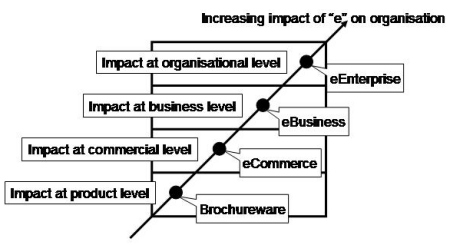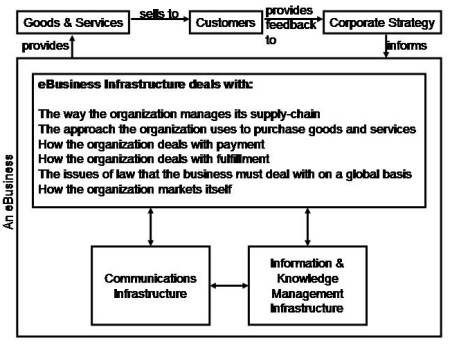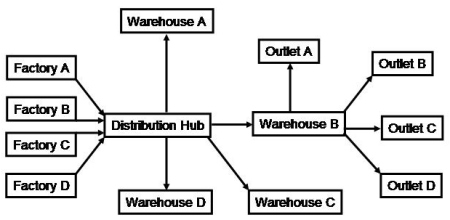LEARNING FOR "
In this reader, we'll look at the components of an enterprise that need to be put in place for it to run on "everyday" basis. We'll do this by:
- Exploring the natural route of development for an enterprise
- Exploring the concept of a business model for enterprise
- Looking at the different components required within an enterprise for it to run on a daily business
- Investigating the different management issues that can arise
The Route of Development for a digital enterprise
The environment in which all businesses operate, and specifically digital enterprises, becomes increasingly complex every day. And the components of any organisation that are most affected by this complex business environment are the components of greatest importance to a digital enterprise, and include:
- The way the enterprise manages its supply-chain
- The approach the enterprise uses to purchase goods and services
- How the enterprise deals with payment
- How the enterprise deals with fulfilment
- The issues of law that the enterprise must deal with on a global basis
- How the enterprise markets itself
We'll look at marketing and customer issues in the sessions on eMarketing and CRM.
In his book "eEnterprise:
Business Models, Architecture, and Components",

The first phase of the route is the brochureware phase - this is when an organisation creates literally electronic versions of brochures, adverts and so on. The next phase is the e-Commerce phase, when the organisation begins to trade electronically with customers. The third phase is the e-Business phase, when the organisation begins to do all business dealings with suppliers, customers and partners electronically. The final phase is the eEnterprise phase, when the organisation manages its entire operation electronically, and its business strategy is based around the organisation adapting its whole business process to the technological opportunity.
- Now do Task 1 from the Tasks Page
A Business Model for digital enterprise
The business model for an enterprise relies on that organisation having an effective communications infrastructure and an information and knowledge management infrastructure. Only then can the infrastructure for an enterprise be created.

Our business model for an digital enterprise contains an infrastructure that addresses the six components we referred to when discussing the complex business environment.
It is these six components that we'll focus on when we look at what a digital enterprise needs to run.
The Components required for an digital enterprise to run
Essentially - what does an digital enterprise need to do? Firstly, we must be able to sell goods and services electronically. We must be able to run the commercial undertakings which are connected to the enterprise. We must be able to run the sophisticated technology underpinning the digital enterprise. We must be able to run the administrative business on a day-to-day basis. Finally we must constantly improve organisational performance.
The six components of the digital enterprise infrastructure need to be considered with these tasks in mind.
The Way the digital enterprise manages its Supply-Chain
Supply-chains are associated with traditional bricks-and-mortar business. A supply-chain is the concept of a relationship that joins together factories (that manufacture goods), distribution hubs (where goods are brought together for redistribution across geographical locations), inventory storage areas (such as warehouses and stockrooms), ways of distributing goods, and shops and other outlets for those goods. The supply-chain relationship is joined together through information, rules and procedures.

Common features of e-Business management of the supply chain include:
- The use of a centralised warehouse attached to the manufacturer so that goods to be sent to customers come from a central point and quality of product and reliability of delivery can be closely monitored.
- The outsourcing of warehouse services to an expert business in the field of warehousing. This allows for the removal of risk by ensuring that warehousing activities are conducted by an organisation that makes that its business.
- The use of drop-shipping by vendors. This allows vendors to draw from the stock of their suppliers directly and have them deliver the goods direct to their customers.
- The use of fulfilment intermediaries. This allows a business to remove itself from direct retail and rely on other companies to broker its goods and services.
All of these approaches have only been made possible because of the use of sophisticated information and knowledge management infrastructures and communication infrastructures. The e-Business approach to supply-chain management allows for increased use of just-in-time delivery, leading to greater speed, greater efficiency of operations, and the potential for cost savings.
- Now do Task 2 from the Tasks Page
The Approach the digital enterprise uses to purchase Goods and Services
The approach an digital enterprise uses to purchase non-strategic good and services electronically is known as eProcurement.
eProcurement can be done through the familiar process of purchasing goods and services online, or through the increasingly important channel of a B2B marketplace. In the development of electronic businesses, we've seen three important strategic stages that seem to occur.
- The processing of transactions electronically
- The sourcing of goods and services in a strategic (and potentially competitive manner)
- Ultimately the making of a transparent market, where the total activities of a supply chain are managed cleverly and openly by all those who work within it.
eProcurement should provide lower costs (in terms of the act of procurement and the goods and services themselves), better coordination of the procurement activity within an the business, and increased efficiency and effectiveness of the procurement activity.
- Now do Task 3 from the Tasks Page
How the digital enterprise deals with Payment
Certainly within the developed, industrialised world, the two most commonly used methods of payment in B2C e-commerce are credit cards and debit cards. This is okay, but there a number of security issues which are commonly raised. There are two protocols used which attempt to deal with these security concerns - these are the Secure Sockets Layer (SSL) and the Secure Electronic Transaction (SET).
SET was developed by Visa and MasterCard and later joined by a number of other charge and credit card houses to create SETCo. SETCo's role is to test any transaction software created by B2C e-commerces, make sure they comply with the SET standard and to maintain the SET cryptographic key used in encrypting financial transactions.
Both SET and SSL use the concepts of digital certificates and encryption to maintain the secrecy and security of transactions. SET is preferred, as only order information is sent to the B2C e-commerce player. Financial information is sent on to a "payment gateway", which authorises the transaction and allows an exchange of funds.
There are a number of other methods of transaction, and these include electronic cheques, electronic cash, virtual payment systems, electronic bill payment service providers and clearing services (such as BACS and CHAPS) run by banks for the transfer of funds between account holders in different banks - many people have salaries paid into their bank accounts using these systems.
When B2B e-Businesses look at financial transactions, they will tend to be involved in a payment gateway service provided by a specialist transaction technology business, as well as existing clearing services provided by their banks.
- Now do Task 4 from the Tasks Page
How the digital enterprise deals with Fulfilment
Because of their "virtual status", one of the biggest challenges for an e-commerce is how it "delivers the goods". From this perspective, an e-commerce player needs to develop a logistical solution that creates an infrastructure for the swift and uncomplicated distribution of goods. eLogistics also allows the development of services that allow the tracking of delivery progress so that customer query can be dealt with effectively.
In order to improve upon the fulfilment issue, e-commerce should look at opportunities to reduce stock levels though trustworthy just-in-time systems, reduce the number of intermediaries (as this removes the number of steps and the cost of the goods), reduce the need to carry out all the activities within a supply chain and leave these to specialists, and improve aspects of their own service which they can then sell on to their business partners.
- Now do Task 5 from the Tasks Page
The Issues of Law that the digital enterprise must deal with on a Global Basis
There are a huge number of specific legal issues that an e-Business needs to be aware, and they fall into these categories:
|
|
Within the European Union,
there are a variety of laws from the individual nation states and also the
Distance Selling Directive, which covers some fundamental points for e-commerces
selling to consumers online inside the EU. There is also some agreement on
how tax is paid on goods sold within the EU. Laws in the
Laws are still new and relatively untried in this area, so e-commerces need to be aware of the continual turmoil that legislation will cause for some time to come.
- Now do Tasks 6, 7 and 8 from the Tasks Page